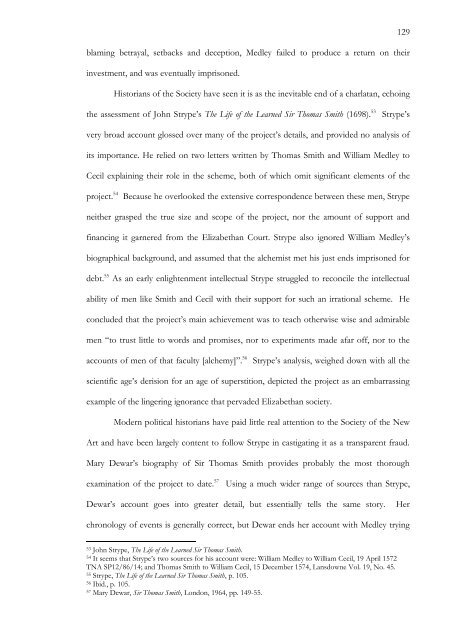The Alchemical Patronage of Sir William Cecil, Lord Burghley
The Alchemical Patronage of Sir William Cecil, Lord Burghley
The Alchemical Patronage of Sir William Cecil, Lord Burghley
You also want an ePaper? Increase the reach of your titles
YUMPU automatically turns print PDFs into web optimized ePapers that Google loves.
laming betrayal, setbacks and deception, Medley failed to produce a return on their<br />
investment, and was eventually imprisoned.<br />
Historians <strong>of</strong> the Society have seen it is as the inevitable end <strong>of</strong> a charlatan, echoing<br />
the assessment <strong>of</strong> John Strype‘s <strong>The</strong> Life <strong>of</strong> the Learned <strong>Sir</strong> Thomas Smith (1698). 53 Strype‘s<br />
very broad account glossed over many <strong>of</strong> the project‘s details, and provided no analysis <strong>of</strong><br />
its importance. He relied on two letters written by Thomas Smith and <strong>William</strong> Medley to<br />
<strong>Cecil</strong> explaining their role in the scheme, both <strong>of</strong> which omit significant elements <strong>of</strong> the<br />
project. 54 Because he overlooked the extensive correspondence between these men, Strype<br />
neither grasped the true size and scope <strong>of</strong> the project, nor the amount <strong>of</strong> support and<br />
financing it garnered from the Elizabethan Court. Strype also ignored <strong>William</strong> Medley‘s<br />
biographical background, and assumed that the alchemist met his just ends imprisoned for<br />
debt. 55 As an early enlightenment intellectual Strype struggled to reconcile the intellectual<br />
ability <strong>of</strong> men like Smith and <strong>Cecil</strong> with their support for such an irrational scheme. He<br />
concluded that the project‘s main achievement was to teach otherwise wise and admirable<br />
men ―to trust little to words and promises, nor to experiments made afar <strong>of</strong>f, nor to the<br />
accounts <strong>of</strong> men <strong>of</strong> that faculty [alchemy]‖. 56 Strype‘s analysis, weighed down with all the<br />
scientific age‘s derision for an age <strong>of</strong> superstition, depicted the project as an embarrassing<br />
example <strong>of</strong> the lingering ignorance that pervaded Elizabethan society.<br />
Modern political historians have paid little real attention to the Society <strong>of</strong> the New<br />
Art and have been largely content to follow Strype in castigating it as a transparent fraud.<br />
Mary Dewar‘s biography <strong>of</strong> <strong>Sir</strong> Thomas Smith provides probably the most thorough<br />
examination <strong>of</strong> the project to date. 57 Using a much wider range <strong>of</strong> sources than Strype,<br />
Dewar‘s account goes into greater detail, but essentially tells the same story. Her<br />
chronology <strong>of</strong> events is generally correct, but Dewar ends her account with Medley trying<br />
53 John Strype, <strong>The</strong> Life <strong>of</strong> the Learned <strong>Sir</strong> Thomas Smith.<br />
54 It seems that Strype‘s two sources for his account were: <strong>William</strong> Medley to <strong>William</strong> <strong>Cecil</strong>, 19 April 1572<br />
TNA SP12/86/14; and Thomas Smith to <strong>William</strong> <strong>Cecil</strong>, 15 December 1574, Lansdowne Vol. 19, No. 45.<br />
55 Strype, <strong>The</strong> Life <strong>of</strong> the Learned <strong>Sir</strong> Thomas Smith, p. 105.<br />
56 Ibid., p. 105.<br />
57 Mary Dewar, <strong>Sir</strong> Thomas Smith, London, 1964, pp. 149-55.<br />
129















